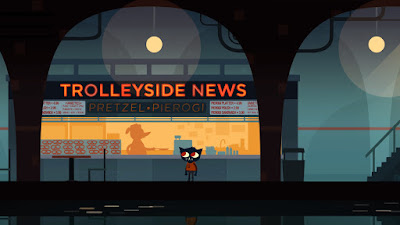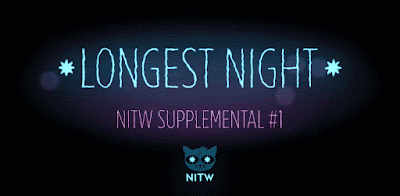Since its original release in 2017, I had heard good things about Night in the Woods, an indie game developed by Infinite Fall and published by Finji after a wildly successful Kickstarter campaign, but I didn’t have the opportunity to actually play it until I got it as part of an itch.io bundle. Since the version I ended up playing was the Weird Autumn Edition, which added a few things to the base game, I have no experience with the originally released version. All the same, I ended up liking the town of Possum Springs and its inhabitants, though the game itself isn’t perfect.
20-year-old Mae Borowski has dropped out of college and returned to her slowly dwindling hometown of Possum Springs. As she learns more about the changes Possum Springs went through while she was away, she hangs out with her old friends, Bea Santello, Gregg Lee and Angus Delaney, all of whom have grown and changed. She also learns that another friend, Casey Hartley, has disappeared and starts having strange dreams at night. Unknown to everyone, however, something dark and mysterious resides in the forest just outside of town.
I don’t normally play games about a college dropout’s life falling apart, but Night in the Woods expertly captures the emotional core of its story. Each of the charming characters has a distinct personality and Mae and her friends are pretty complex, with their own flaws and insecurities that affect them into adulthood. Although Mae herself isn’t that great a person, she feels fairly realistic and I found one scene in particular, when she airs her insecurities to herself in a mirror, pretty relatable. The game also goes into her mental health and how it wasn’t properly addressed when she was younger, which eventually ties into why she ended up dropping out of college despite all that her parents went through to get her in. Since I played the game after Alec Holowka, one of the game designers, tragically took his own life, the knowledge of his own mental health issues added another layer to Mae’s issues.
Depending on whether Mae spends more time with Bea or Gregg throughout the roughly one-and-a-half weeks of the game, the player can view one of two different storylines, each with their own compelling commentaries on life. Bea’s story is about how poverty and responsibility can limit someone’s ambitions or options for the future, such as her inability to go to college outside of free online courses, so she resents Mae for throwing away the dream she can’t have. Gregg’s story involves committing crimes like he and Mae used to do when they were younger, leading into a discussion about how people can not only grow and change, but should be allowed to if they’re trying to better themselves. By the end of both storylines, I felt more attached to the characters and felt like I understood them a lot better. I also appreciated that despite highlighting the harsh reality of adult life, it also understands that the characters are still young and there can always be a light at the end of the tunnel. It’s worth playing the game twice to see Bea and Gregg’s stories, but this process also felt a little tedious, since you still have to go through everything else again.
 |
| Gregg's story has some good dark humor. |
Although I greatly enjoyed the stories involving Possum Springs, including the side activities and the great environmental storytelling that gives the town a clear history and personality, I wasn’t sure how I felt about the cosmic horror element. The story did a great job building it up, with some foreshadowing more evident on a second playthrough, but the execution felt lacking, almost like it was tacked on. I can appreciate a good cosmic horror story, and I liked the implication that this game involved a Lovecraftian Outer God, but it might have worked better if the two sides of Night in the Woods’ story were more interconnected instead of the rather slow buildup and near lack of payoff.
Night in the Woods has rather simple gameplay, since it plays like an interactive narrative with platforming elements that let Mae access more of the town. It also features minimal controls, with very few keyboard keys and multiple controller buttons performing the same actions, which helps make the game more accessible. Every so often, the player will come across a simple mini-game to help increase immersion in Mae’s actions, though these largely consist of moving her arm and grabbing things in a certain way. One of the more complicated mini-games involves playing bass during band practice or in Mae’s room, which introduces Guitar Hero-style rhythm gameplay, albeit more minimal. The songs Mae can play aren’t too difficult to perfect, with perhaps the exception of “Pumpkin Head Guy”, which involves more complex patterns and timing. Occasionally, players can also choose what Mae says during certain conversations, which directly affects the flow of the scene, though as far as I can tell these choices don’t have any long-term consequences. Getting a high jump also feels a little awkward in places, since it requires jumping three times in the same direction and without losing momentum, so reaching certain platforms can mean making the most out of a space just wide enough for it.
 |
| Playing bass provides an interesting change of pace. |
Players can choose how Mae spends each day in Possum Springs, whether they focus solely on the story or talk to some of the NPCs around town for side stories that can have some effect on the larger story. Some events are time-sensitive, meaning they’ll only occur on specific days and can permanently close themselves off to players who don’t indulge in them. Either way, Mae will record her experiences in a journal, which has a rather tragic in-universe explanation, and finding what actions or storylines award Mae another page can act as a side quest in itself thanks to the existence of an achievement tied to filling in the entire book. Completionists should be wary, however, since the game keeps track of all pages between playthroughs but will show you a completely blank book each time the player starts a new game.
 |
| Mae's journal gradually fills up over the course of the game. |
As if that wasn’t enough, Mae has dreams at night that are pure platforming sequences. The imagery in these sequences get explained a little in an optional side story, but they add to the supernatural element of the main story and eventually lead to a memorable sequence in the latter half of the game. Those looking for more traditional gaming elements, however, may find themselves sinking hours into a game called Demontower on Mae’s laptop, which the developers impressively programmed as a full roguelike complete with procedurally generated dungeons.
Part of the game’s appeal also lies in its simple, yet visually appealing and surprisingly expressive art style. Although each character’s face doesn’t change all that much, except for Gregg, it’s the little details that help greatly with selling a character’s emotions. For Mae in particular, I liked a subtle detail that her damaged ear twitches while she’s idle. Other small details exist to show the passage of time, including one where a pregnant raccoon NPC is later seen pushing a stroller. That said, I did find it hard to read the lyrics or pay attention to the unique visuals while playing bass since all of my attention was focused on not missing any notes. The only solution I could think of for this is watching gameplay footage after the fact or knowing the songs well enough that you can briefly take your eyes off the song.
 |
| Small touches help make Possum Springs feel lived-in. |
Though there isn’t really any voice acting to speak of, outside of maybe Mae’s noises when she jumps, the soundtrack and sound design are both on point. There’s enough variety to flesh out the world while still feeling unified under a distinct electronic and piano style with light instrumentation. It’s not as memorable as some other games, like say Undertale, but I liked it enough that I might want a physical CD in the future if one was released.
The Weird Autumn Edition of the game also includes two gameplay demos released during development of the full game so the developers could have something released while exploring some ideas they had for Night in the Woods. The first of these, Longest Night, came out shortly after the Kickstarter campaign and features Mae and her friends discussing the constellations in the night sky. Apart from reading dialogue, gameplay in this demo consists mainly of drawing the constellations they talk about, which felt awkward enough with a controller that I briefly switched to using a mouse for better precision. While short, Longest Night provides a little context to some of Mae’s interactions in the full game and the ending helps tie the experience into the larger narrative, but leaves it open to whether it’s a prequel or simply a dream.
Lost Constellation, the other demo, plays a bit differently and feels more fleshed out compared to its predecessor. Here, players assume the role of Adina Astra as she searches for the Forest God so she can escape the woods during a harsh winter. Context is provided through a framing device where Mae’s grandfather is telling her a bedtime story about Adina, one of the constellations the player can see during a side quest in Night in the Woods. The frame story comes back every once in a while, even reacting to the player’s failure much in the same way as Prince of Persia: The Sands of Time, where death is treated as a mistake in telling the story or Mae interrupting her grandfather and steering it in her own direction. This approach adds a bit of character and helps the experience feel more natural, which I really appreciated.
As Adina, players can jump around and interact with objects, as well as collect snow to make and throw snowballs. This sounds simple, but leads to some interesting puzzles where players have to aim snowballs at snow in the trees or other objects to get an NPC’s attention. One puzzle in particular tests the player’s precision and timing and involves interacting with some very interesting characters in the forest. There’s also a minigame where Adina builds snowmen to act as vessels for the deceased, who help her at certain points in her quest until they sadly and inevitably lose their connection to the mortal plane. I only really had two complaints about the demo, that ringing a bell with a snowball required more precision than any other puzzle and that going too far to the right requires walking all the way back through the forest, but I still found Lost Constellation a charming experience and a better representation of the final game.
 |
| Adina feels like a fully fleshed-out character. |
Even with some small annoyances here and there, and an
underdeveloped cosmic horror plotline, Night in the Woods is still an
interesting look at the realities of adulthood and life in a dying small town while
still providing a sense of hope for the characters. If you’ve heard of the game
or are looking for a good example of a Kickstarter game, Night in the Woods
can certainly satisfy. Considering how it ends, however, you’ll have to gauge
for yourself if you think it’s worth the full price of $20.




No comments:
Post a Comment